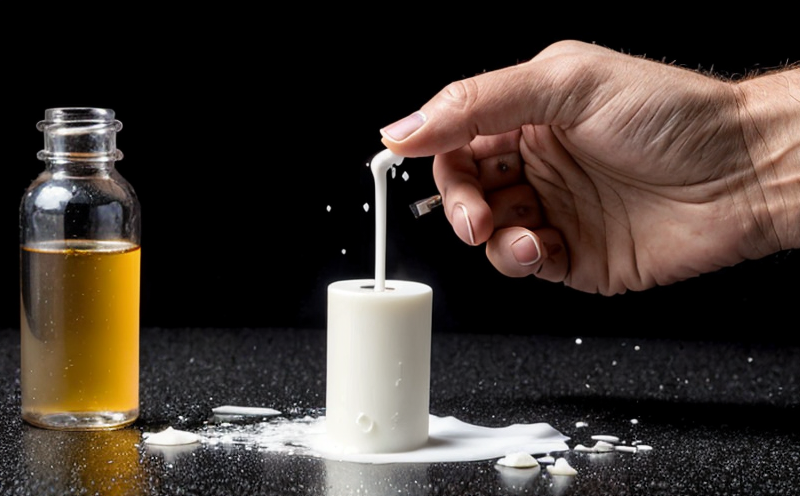USP Cream Dissolution Testing
The United States Pharmacopeia (USP) provides a comprehensive set of standards, tests, and guidelines to ensure that medicines are safe and effective. One crucial aspect of pharmaceutical testing is dissolution testing, which evaluates the rate at which active ingredients in dosage forms dissolve into a liquid medium over time. This is particularly important for creams and ointments, as their effectiveness depends on the rapid release of active compounds.
USP Cream Dissolution Testing focuses specifically on determining how quickly the active ingredients within a cream or ointment disintegrate and dissolve in water. This test assesses the drug's bioavailability by measuring its rate of dissolution and ensuring it meets predefined standards set forth by USP guidelines. The testing process is critical for quality control, regulatory compliance, and patient safety.
The procedure involves placing a specified amount of cream into a dissolution apparatus containing a predetermined volume of water at a controlled temperature. A paddle or stirrer rotates to ensure uniform mixing. Over time, the cream samples are agitated, allowing the active ingredients to dissolve into the aqueous solution. The concentration of dissolved drug is then measured using analytical techniques such as UV-Vis spectrophotometry or HPLC.
This method helps identify any issues related to drug stability, formulation, or manufacturing processes that might affect the cream's performance. For instance, poor dissolution rates could indicate suboptimal excipient selection or processing conditions. Conversely, excessively rapid dissolutions may suggest instability of the active ingredient.
The importance of USP Cream Dissolution Testing extends beyond just meeting regulatory requirements; it also ensures consistent product quality across batches and manufacturing sites. By adhering to these stringent standards, manufacturers can maintain high levels of patient trust while reducing the risk of ineffective treatments or adverse reactions due to improper drug delivery.
Applied Standards
The USP sets forth specific guidelines for conducting Cream Dissolution Testing. These standards are based on rigorous scientific research and extensive feedback from industry experts, ensuring that they remain relevant and applicable across various formulations and environments.
- USP 1079: This section outlines the general principles of dissolution testing for creams and ointments. It specifies the equipment required, including a suitable dissolution apparatus with appropriate paddle or stirrer speed settings.
- USP 231: Provides detailed procedures for performing the actual test, including sample preparation, temperature control, and data collection methods.
- USP 601: Covers acceptance criteria which define what constitutes acceptable dissolution profiles. These limits ensure that all batches of cream meet minimum standards regarding bioavailability.
The USP also recommends using validated analytical techniques for quantifying the amount of dissolved drug, such as high-performance liquid chromatography (HPLC) or ultraviolet-visible spectroscopy (UV-Vis). By following these standardized procedures and criteria, laboratories can ensure accurate and reliable results that align with industry expectations.
Scope and Methodology
The scope of USP Cream Dissolution Testing encompasses a wide range of products intended for external application. This includes but is not limited to various types of creams, lotions, ointments, pastes, and gels designed to treat skin conditions or deliver topical medications.
Methodologically speaking, the process involves several key steps:
- Sample Preparation: Collect a representative sample from each batch or production run. Ensure that it is free from contaminants and properly labeled.
- Dissolution Apparatus Setup: Assemble the dissolution apparatus according to manufacturer instructions, ensuring all components are clean and functioning correctly.
- Temperature Control: Maintain a constant temperature within ±0.5°C of the specified value throughout the testing period.
- Dissolution Medium: Use distilled water or another suitable solvent as per the test method described in USP 1079.
- Timed Agitation: Rotate the paddle or stirrer at a set speed to ensure consistent mixing.
- Data Collection: Regularly withdraw aliquots from the dissolution medium and analyze them for active ingredient concentration using appropriate analytical techniques.
- Analysis: Compare the collected data against established acceptance criteria specified in USP 601.
The entire procedure should be conducted under strict quality assurance protocols to minimize variability and ensure reproducibility. Proper documentation of all steps is essential for compliance with regulatory bodies like the FDA.
Industry Applications
| Industry Segment | Description | Dissolution Criteria |
|---|---|---|
| Topical Medications | Treatments for dermatological conditions such as psoriasis, eczema, and acne. | Absorption rates must be optimal to provide effective relief without causing irritation. |
| Sunscreen Formulations | Products designed to protect against ultraviolet radiation. | Dissolution should be rapid enough to form a protective layer on the skin efficiently. |
| Wound Care Products | Creams and pastes used in healing wounds or preventing infections. | Active ingredients need to dissolve quickly to promote wound healing. |
| Anti-itch Creams | Medicated creams intended to soothe itchy skin conditions like eczema. | The cream must begin acting promptly to alleviate discomfort. |
| Hydration Treatments | Products aimed at improving skin hydration and elasticity. | Dissolution profiles should support prolonged moisture retention in the skin. |
| Sports Recovery Creams | Treatments used post-exercise to aid muscle recovery and reduce pain. | The cream should begin working swiftly to enhance recovery times. |
Understanding these applications highlights the importance of accurate dissolution testing in maintaining product efficacy across diverse markets. Ensuring consistent compliance with USP standards can help manufacturers meet market demands while safeguarding public health.





